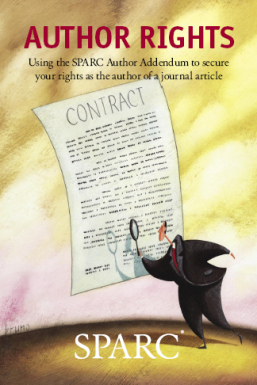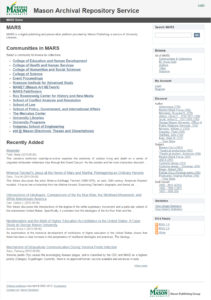Need images and other media for assignments, teaching materials, and websites? See the list below for ideas on where to find copyrighted content in databases available to you through the University Libraries’ subscriptions. To find content you can share, use, and perhaps modify without worrying about copyright infringement, search in the Creative Commons portal or explore works in the public domain. But remember, scholarly practice requires attribution to the original creator no matter whether the item is protected by copyright law, available under a Creative Commons license, or in the public domain.
 Mason Publishing Group
Mason Publishing Group
Copyright FAQs
Looking for a quick answer to a specific question? The Scholarly Communication and Copyright Office’s Frequently Asked Questions might have the answer. If not, please contact us at publish@gmu.edu.
Fair Use | Requesting Permission | File Sharing | Dissertations/Theses
Fair Use
What is fair use?
Fair use is the term used for the limited exception to the exclusive rights granted to an author or creator by copyright law. The fair use doctrine allows limited use of copyrighted material without permission from the rights holder for certain activities such as research, instruction, criticism, commentary and news reporting.
How do I know if my use of copyrighted material is fair use?
There are several factors that will weigh in favor of fair use, but it is helpful to use a checklist to help you determine if your use is fair or not.
George Mason University Fair Use Checklist
Fair Use Evaluator
Digital Millennium Copyright Act
Enacted in 1998, the Digital Millennium Copyright Act (DMCA) was the legislative response to U.S. implementation of the World Intellectual Property (WIPO) copyright treaty (The Digital Millennium Copyright Act of 1998: U.S. Copyright Office Summary. 1998). Passage of this and similar legislation resulted largely in the Internet as we know it today–a compromise between copyright holders, who seek to protect their content from rampant reproduction and distribution via the Web, and Internet Service Providers (ISP), who want limited liability for content users’ indiscriminate infringement activities on their networks. At a local level, provisions in the DMCA significantly affect campus file sharing behavior at George Mason University.
Section 512(c) of the DMCA specifically limits the liability of the University, as the ISP for our community, for copyright infringements made by students, faculty, and staff. This protection is granted as long as the University:
- has no knowledge of the infringing activity,
- does not receive a financial benefit directly connected to infringing activity over which it has control,
- removes or blocks access to material, upon receipt of a notice claiming copyright infringement,
- has a written copyright policy, and
- has a designated agent, registered with the U.S. Copyright Office, to whom DMCA notices may be sent.
File Sharing
File sharing protocols have become a common method for sharing all types of content, both legally owned and unlawfully acquired, among and between computer users. With the advent of Napster in 1999, these protocols have grown exponentially. Torrent and Gnutella sites, such as Frostwire and Ares, facilitate distribution of content, often without permission from the owner of that content. This causes tension between the copyright owner, who wants to maintain control over his/her works, and individuals who want to use, enjoy, share, and build on these works.
Users must be aware of the fact that access to content on the Web is not equivalent to owning that content. You can watch, listen to, and read online content 24/7. But you may not have the right to download the material and/or use it the way you would like, unless you make payment to or have permission from the copyright owner. A Creative Commons license explicitly stipulates how users may use the content. Otherwise, assume that all content on the Web is owned by someone, even if it isn’t marked with a copyright symbol.
Industry Slant
The Business Software Alliance (BSA) is a trade organization representing software companies and their hardware partners.
BSA on Internet Piracy
BSA on Software Licensing
The Motion Picture Association of America (MPAA) serves as a “voice and advocate” for its members, the six major motion picture studios, and their interests in the motion picture, home video, and television industries.
Why the MPAA Cares About Copyright
Types of Content Theft
The Recording Industry Association of America (RIAA) is a trade organization for the major music companies who are their members. RIAA members record, manufacture, and distribute 85% of “legitimate recorded music” in the United States.
RIAA on Piracy
Course Packs
There is no such thing as a “fair use course anthology.” Instructors who choose to create a course pack of required readings for his/her students should conduct a fair use analysis for each item to be included in the pack. Use the Fair Use Evaluator tool to help you determine whether your proposed use is defensible as a fair use. You may also refer to the U.S. Copyright Office’s Reproduction of Copyrighted Works by Educators and Librarians (PDF) for more specific information, or call the Copyright Office for assistance.
When a proposed use of any copyrighted work appears to go beyond fair use limitations, you may decide to develop a course pack. Please contact Jared Prebish (703-993-3835) with the Mason Bookstore for assistance.
Negotiate author rights
Consider using addenda to a standard publisher’s agreement to request a bundle of key rights you will need to share your article. The following examples offer contract language you may draw from to create your own addendum, or you may use one verbatim.
 The SPARC Author Addendum is a legal instrument that authors may use to modify their publisher agreements, enabling them to keep selected key rights to their articles, such as:
The SPARC Author Addendum is a legal instrument that authors may use to modify their publisher agreements, enabling them to keep selected key rights to their articles, such as:
- Distributing copies in the course of teaching and research,
- Posting the article on a personal or institutional Web site, or
- Creating derivative works.
The Science Commons: Scholar’s Copyright Addendum Engine is another handy tool to help you negotiate author rights. Use it to generate language customized to your manuscript, including a range of access options.
Each addendum gives you non-exclusive rights to create derivative works from your Article and to reproduce, distribute, publicly perform, and publicly display your article in connection with your teaching, conference presentations, lectures, other scholarly works, and professional activities. However, they differ with respect to how soon you can make the final published version available and whether you can authorize others to re-use your work in various ways.
The Committee on Institutional Cooperation (CIC), a consortium of 13 American universities, offers a model addendum to publication agreements that “affirms the rights of authors to share their work in a variety of circumstances, including posting versions of the work in institutional or disciplinary repositories.” This addendum may be modified on a case-by-case basis, as needed, but it offers contract language that ensures authors greater control over their scholarly output.
Deposit your research and data in MARS
The Mason Archival Repository Service (MARS) is a service of Mason Publishing and Data Services at the George Mason University Libraries. MARS provides access to the intellectual work of the George Mason University community, archiving Electronic Theses and Dissertations by graduate students at Mason, faculty research publications, and data files.
Why take advantage of MARS?
- Create a permanent record of your work.
- Avoid data loss and server maintenance. Not only do we make sure your research isn’t lost on a hard drive crash, we make sure it’s available in current, usable data formats.
- Increase your impact. Your work will be easy to find in web services like Google Scholar.
- Migrate your print research into the digital world. We can help you digitize your analog materials and make them available online (depending on copyright).
What can you archive in MARS?
Many journal publishers allow you to deposit preprint (before peer-review) or postprint (final draft after peer-review) versions of published articles in a repository like MARS. Some allow you to archive the publisher’s final version.
In addition to formally published scholarship, consider archiving presentations, working papers, blog posts, and podcasts. We can handle text, image, video, and audio formats.
Consider sharing data that supports your publications by depositing it in or another digital repository. Some granting agencies require applicants to include a data management plan to explain if, how, and when research data will be shared. Learn more about Mason’s Data Services.
Confused about copyright? We can help you sort it out.
Whether you want to increase the circulation of your scholarship or you need help complying with Open Access mandates for your research data and publications, we are here to help. To start publishing your content in MARS click here to use our online form.
OER Part 3: Grants, Advocacy, and Guidelines
Learn more about how you can support the adoption and development of high-quality open courses and educational resources by checking out the following resources on grants, OER advocacy, and other OER guidelines. The rest of our series on Open Educational Resources (OER) features collections of open courses, textbooks, and course content that you may use, re-purpose, and distribute for your teaching and learning needs.
Part 1: Course Content and Textbooks | Part 2: Open Courses and MOOCs | Part 4: K-12 Resources | Part 5: Articles and Research
Predatory Open Access Publishers
 Check out Beall’s List of Predatory Open Access Publishers and journals list if you receive manuscript solicitations from purported academic publishers with which you are unfamiliar. University of Colorado librarian Jeffrey Beall expresses caution in dealing with the publishers he lists because invariably they are in it for the money that can be made from charging authors article processing fees. Often these businesses have questionable review practices, bogus editorial boards, and/or their websites mimic the look of well-established publishers. See The Scientist article for Beall’s explanation of how a publisher or journal winds up on one of his lists or read his criteria here.
Check out Beall’s List of Predatory Open Access Publishers and journals list if you receive manuscript solicitations from purported academic publishers with which you are unfamiliar. University of Colorado librarian Jeffrey Beall expresses caution in dealing with the publishers he lists because invariably they are in it for the money that can be made from charging authors article processing fees. Often these businesses have questionable review practices, bogus editorial boards, and/or their websites mimic the look of well-established publishers. See The Scientist article for Beall’s explanation of how a publisher or journal winds up on one of his lists or read his criteria here.

